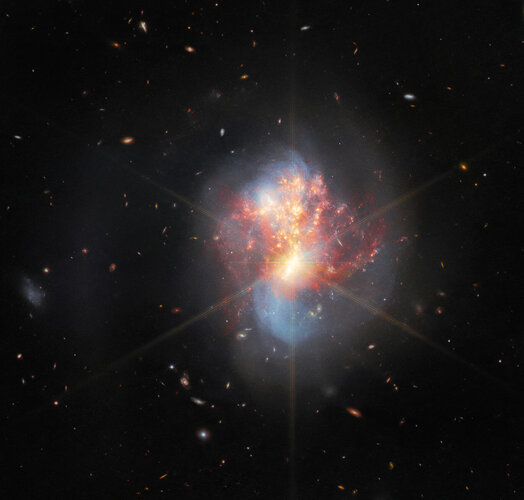Here, the Webb Picture of the Month of merging galaxies IC 1623 A and B is juxtaposed with a new image from the NASA/ESA Hubble Space Telescope. This image on the right, combining data from Hubble’s ACS and WFC3 instruments, gives a familiar visible-light view of these colliding galaxies, where the centres of the individual galaxies are much more obscured by dark dust. Meanwhile, in Webb’s combined MIRI and NIRCam view of the galaxies on the left, the gas being used as fuel by the stellar nurseries is especially apparent. Webb’s ability to pierce the gaseous veil obscuring the bright galactic cores also causes prominent diffraction spikes to appear.
The image on the left from the NASA/ESA/CSA James Webb Space Telescope depicts IC 1623, an entwined pair of interacting galaxies which lies around 270 million light-years from Earth in the constellation Cetus. The two galaxies in IC 1623 are plunging headlong into one another in a process known as a galaxy merger. Their collision has ignited a frenzied spate of star formation known as a starburst, creating new stars at a rate more than twenty times that of the Milky Way galaxy.
This interacting galaxy system is particularly bright at infrared wavelengths, making it a perfect proving ground for Webb’s ability to study luminous galaxies. A team of astronomers captured IC 1623 across the infrared portions of the electromagnetic spectrum using a trio of Webb’s cutting-edge scientific instruments: MIRI, NIRSpec, and NIRCam. In so doing, they provided an abundance of data that will allow the astronomical community at large to fully explore how Webb’s unprecedented capabilities will help to unravel the complex interactions in galactic ecosystems. These observations are also accompanied by data from other observatories, including the NASA/ESA Hubble Space Telescope, and will help set the stage for future observations of galactic systems with Webb.
The merger of these two galaxies has long been of interest to astronomers, and has previously been imaged by Hubble and by other space telescopes. The ongoing, extreme starburst causes intense infrared emission, and the merging galaxies may well be in the process of forming a supermassive black hole. A thick band of dust has blocked these valuable insights from the view of telescopes like Hubble. However, Webb’s infrared sensitivity and its impressive resolution at those wavelengths allows it to see past the dust and has resulted in the spectacular image above, a combination of MIRI and NIRCam imagery.
The luminous core of the galaxy merger turns out to be both very bright and highly compact, so much so that Webb’s diffraction spikes appear atop the galaxy in this image. The 8-pronged, snowflake-like diffraction spikes are created by the interaction of starlight with the physical structure of the telescope. The spiky quality of Webb’s observations is particularly noticeable in images containing bright stars, such as Webb’s first deep field image.
MIRI was contributed by ESA and NASA, with the instrument designed and built by a consortium of nationally funded European Institutes (The MIRI European Consortium) in partnership with JPL and the University of Arizona.
NIRSpec was built for the European Space Agency (ESA) by a consortium of European companies led by Airbus Defence and Space (ADS) with NASA’s Goddard Space Flight Center providing its detector and micro-shutter subsystems.
Results based on this observation of IC 1623 have been published in the Astrophysical Journal.



 Image:
Webb explores a pair of merging galaxies
Image:
Webb explores a pair of merging galaxies